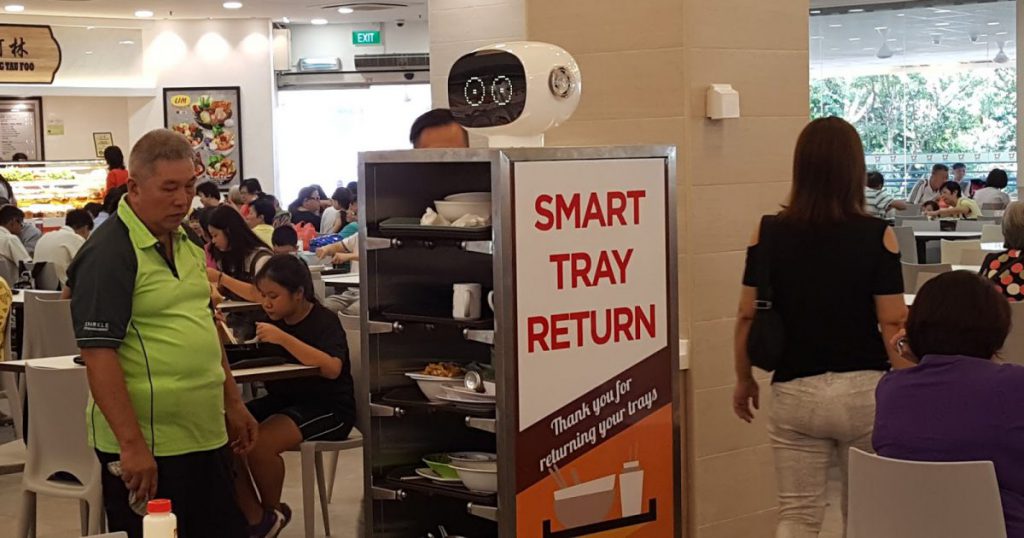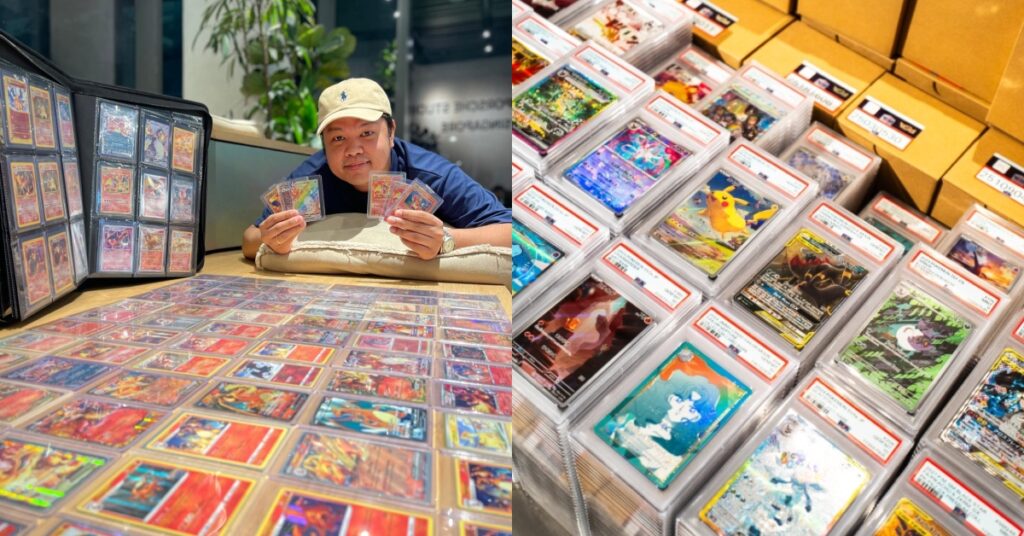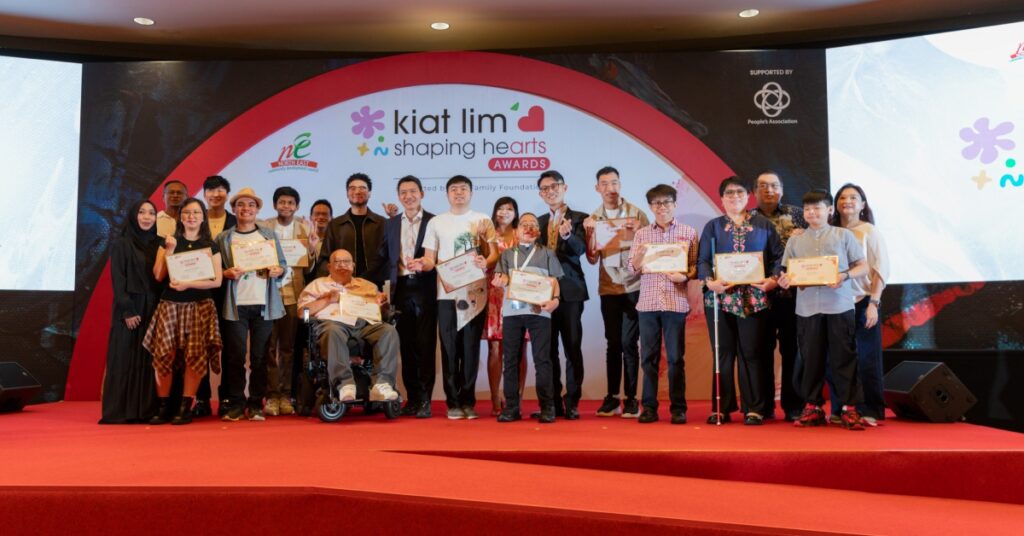When I go to a coffee shop or hawker centre, the tables are usually filled with leftover food and plates left behind by the previous patron.
Usually, an elderly lady or man would slowly hobble their way to the table pushing a cleaning trolley to clear the table.
Food centres these days are equipped with those metal shelves where patrons can return their own trays and used cutleries. At Khoo Teck Puat Hospital’s food court, patrons separate their wastes and the different cutleries into the different bins provided.
Lately, I have noticed that hawker centres like the one at Ci Yuan Community Centre have cash registers at each stall that resemble a small cupboard.
Customers now feed the cash into the box as the display atop the box shows the order and the total amount to pay.
Soon enough, all our hawker centres and coffee shops will become cashless and maybe even man-less – and it’s a reality that’s already taking place!
A Smart Nation Should Also Have Smart Kopitiams
In May this year, two heartland kopitiams implemented a new technology-driven system to improve productivity in the premises.
The Happy Hawkers coffee shop, which is managed by Koufu, at Block 872C Tampines Street 86 has “[s]elf-ordering kiosks, an automated tray return system and a floor cleaning robot” to shorten time spent waiting in the queue, The New Paper reported.
Tray return robots roam the coffee shop to collect patrons’ used trays.
Another coffee shop at Choa Chu Kang Avenue 1, FoodTastic which is run by Chang Cheng boasts these smart features as well. Specifically, FoodTastic has the Elmo-looking floor-cleaning robot and a shredder to make disposal of waste food easier.
These are the two coffee shops participating in a pilot programme to transform traditional public food centres into “productive coffee shops” as Senior Minister of State for Trade and Industry, Sim Ann calls them.
Should this programme be successful, coffee shops in Bukit Batok, Punggol, and Yishun, will bid for this under Spring Singapore and the Housing Development Board (HDB).
Since last year, Koufu had these tray return robots traversing its Punggol outlets, cutting down on labour hours by half.
Tray-returning habits have not improved even with the encouragement from the government.
So, these smart robots became the answer to tackle that problem.

In July this year, it was announced that a ‘smart hawker centre’ will open at Jurong West Street 61 in October.
What’s interesting about this is that it also has tray return machines that go around collecting them, but patrons get 20 cents when they return their own trays.
A move that hopes to encourage the public to pick up the habit.
The smart hawker centre includes self-payment kiosks, similar to the productive coffee shops. FoodTastic has “a centralised ordering kiosk” and Happy Hawkers has a kiosk for each stall but patrons can also order food from other stalls too.
The Challenge To Transform A ‘Cash Is King’ Mindset

A mobile payment platform, Liquid Pay, reported that according to MasterCard, 69 per cent “of consumer value spend is made via electronic payments, surpassed only by Japan and Korea”.
Cash circulation is “surprisingly high” in Singapore, considering it takes up 8.8 per cent of our GDP as compared to 4.4 per cent in Australia and 2.12 per cent in Sweden.
But what’s wrong with paying by cash?
Managing director of the Monetary Authority of Singapore (MAS) said about S$2 billion – or 0.5 per cent of GDP – per year is expended.
According to a testimonial from Liquid Pay, a stall owner said, “It would be great if hawkers can focus on cooking and preparing food, leaving payments to the smartphone”.
Even though CEO of Liquid Pay, Jeremy Tan is positive about his simple and useful cashless solution making an impact, another testimonial is sceptical saying that “changing the habits of older hawkers and customers takes time”.
Liquid Pay is just one such vendor trying to make payments more inclusive for food stall owners using QR code payment.

DBS this year started collaborating with hawkers and neighbourhood shops using its PayLah! app.
It recruited up to 1,000 ambassadors to reach out “across the island to encourage small, cash-based merchants to adopt DBS PayLah! QR codes as a payment method”.
This goes in line with the Smart Nation Ambassador Programme (SNAP). The bank has also rolled out this payment system with taxi company, ComfortDelGro.
This article has also outlined that “[c]ash accounts for more than 80 per cent of payments at small shops, and 90 per cent at hawker centres and wet markets.”
According to the Hawker Centre 3.0 report by the Ministry of the Environment and Water Resources (MEWR), the median age of our hawkers now is “relatively high” at 59-years-old.
These hawkers could be not as tech-savvy or are unwilling to change what they are already familiar with, but perhaps, with the help of government agencies and private vendors, more of our hawkers and coffee shops will be transformed.
The Hawker Centre 3.0
A 14-member “multi-disciplinary Hawker Centre 3.0 Committee” was also set up to focus on four key areas.

Each of the four focus areas have a set of recommendations assigned to them to ensure that they are achieved.

Under this scheme, the committee hopes to attract younger people to become hawkers, providing necessary training on the tender process and the operations of a hawker stall, as well as imparting “practical and basic skills” on cooking.
“Incubation stalls” will be set up for new hawkers for a trial period of six to 12 months for them to learn and make their career decision. These stalls will also be equipped with the basic hawker equipment so that those on the trial “need not spend so much”.
Hawkers can also focus on cooking and serving food to customers as “centralised dishwashing, cashless payment and bulk purchasing of common ingredients” have been proposed to the Government.
Additional amenities such as free Wi-Fi access for customers, and entertainment like “music performances and festive celebrations to enhance hawker centres’ vibrancy and customers’ dining experience” have been proposed as well.
Sentiments On The Ground
Inevitably, this has brought rise to sentiments like the high costs of implementing the new tech potentially transferring to food costs, and the tech not being user-friendly.
However, Chang Cheng said the high-tech upgrade at FoodTastic “cost $1 million more to build… but that the long-term benefits included leaner manpower, reduced by almost 50 per cent”.
Koufu agreed, even though “its new coffee shop cost ‘around 70 per cent more’ to build… the non-halal kitchen needs 10 staff at most, instead of 16 to 18 workers”.
With the technological upgrades, both companies assure the public that coffee shop prices will still be affordable and that the prices are “benchmarked against coffee shops in the vicinity”.
But what wasn’t addressed is the point that automation could cause a number of hardworking individuals to lose their jobs.
Many people are worried that the elderly janitors working at these places will be made redundant as machines replace them even if they had made the effort to upgrade themselves.

So while we enjoy greater convenience patronising our favourite stalls at hawker centres and coffee shops, we cannot ignore the fact that some social issues may follow. Do you think this is, overall, a welcome upgrade in society?
Featured Image Credit: Corylogics.blogspot.sg











